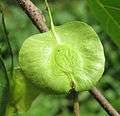Holoptelea integrifolia
Holoptelea integrifolia, the Indian elm or jungle cork tree,[2] is a species of elm native to most of Indian subcontinent, Indo-China and Myanmar. It is found mostly on plains but also in mountains on elevations up to 1100 m.
| Holoptelea integrifolia | |
|---|---|
 | |
| At Amravati, India | |
| Scientific classification | |
| Kingdom: | Plantae |
| Clade: | Tracheophytes |
| Clade: | Angiosperms |
| Clade: | Eudicots |
| Clade: | Rosids |
| Order: | Rosales |
| Family: | Ulmaceae |
| Genus: | Holoptelea |
| Species: | H. integrifolia |
| Binomial name | |
| Holoptelea integrifolia | |
| Synonyms[1] | |
| |
Description
The Indian elm is a large deciduous tree, about 20–25 m tall (rarely over 30 m), with a broad crown featuring several ascending branches. Bark is grey in colour, covered with blisters, peeling in corky scales on old trees. Leaves are alternately arranged, elliptic-ovate in shape, 8–13 cm long and 3–6.5 cm wide, smooth, with entire margins (occasionally toothed), and a pointed tip. Leaf base is rounded or heart-shaped. Stipules are lance-shaped. Crushed leaves emit an unpleasant odour. Flowers are small, greenish-yellow to brownish, pubescent, borne in short racemes or fascicles at the scars of fallen leaves. Sepals are velvety, often 4. Fruit is a circular samara, 2.5 cm in diameter, with membranous, net-veined wings, and flat seed.
Cultivation and uses
Holoptelea integrifolia is used for timber which makes cheap furniture and also used as firewood in rural parts. It is also used in ecologial forestry for its heat and drought tolerance and regenerative abilities. Its flowers, leaves and bark have medicinal uses against several diseases.
Gallery
.jpg) 18th century illustration flora of the coast of Coromandel Coast India Plants
18th century illustration flora of the coast of Coromandel Coast India Plants- Holoptelea integrifolia leaf in Akola, India
_(3204081018).jpg) A mature Indian elm tree in fall
A mature Indian elm tree in fall.jpg) Bark
Bark.jpg) Flower
Flower Unripe fruit
Unripe fruit_01.jpg) Ripe fruit
Ripe fruit
References
- "Holoptelea integrifolia". Plants of the World Online. Royal Botanic Gardens, Kew. Retrieved 30 March 2020.
- "Holoptelea integrifolia". Germplasm Resources Information Network (GRIN). Agricultural Research Service (ARS), United States Department of Agriculture (USDA). Retrieved 30 March 2020.